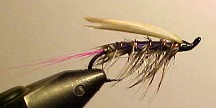some combinations just won't quit

Looks Strange,
Fishes Well.
As Spring creeps into the high country we continue to fish the rivers and streams that are near to Yellowstone National Park. It's sometimes hard to tell when Winter ends and Spring begins. Probably if there are less days with snow than rain, it's Spring. It was Spring last week, and Winter this week.
This is the fly that we are currently fishing, (along with some others,) and it is doing as good a job as it did all Winter. It's called the "Yellowstone Winter Grub," and is reminiscent of steelhead flies used around Salmon, & Chalis, Idaho in the early season. Later they will switch to leeches and buggers, we will switch to the "Yellowstone Duster," (about next week - depending on water color & flow.)
Both Messrs Barnes & Brooks fished this fly, but seldom mentioned it. It has been in the fly boxes of locals for at least 30 years, and gets less attention than it deserves. It is heavy, needs no split shot, has internal action, and catches fish.
Recipe for "Yellowstone Winter Grub:"
Tail: fine magenta & brown deer hair, Butt: just a bit of yellow ostrich herl, Body: dark purple floss, Ribbing: heavy copper wire, Body Hackle: grizzly hen, or mallard, or wood duck, Beard: a few fibers of body hackle, or one wrap of body hackle - pulled down, Wing: light brown turkey tail tip, (not white!,) or chestnut turkey quill, Head: black. There are several variations for the wings, - tied low, tied medium high, (shown,) or even tied very low, (below the body on each side,) like some of the salmon flies of the old world. All work well. Hook Sizes: 2 - 10, heavy nymph, or salmon style. Fish the fly in classic steelhead fashion; controlled casts, loose swing for 1/2 the drift then tighten up and let the fly swing all the way to the bank. Most takes are at the very end of the swing. However, this time of year the action of the fly may induce early takes as well.



.jpg)







No comments:
Post a Comment